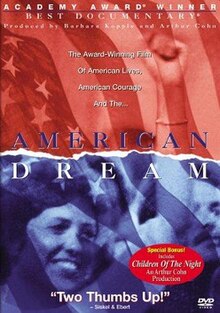American Dream (film)
| American Dream | |
|---|---|

DVD cover
|
|
| Directed by |
Barbara Kopple Co-directors: Cathy Caplan Thomas Haneke Lawrence Silk |
| Produced by |
Arthur Cohn Barbara Kopple |
| Music by | Michael Small |
| Cinematography | Tom Hurwitz Mathieu Roberts Nesya Shapiro |
| Edited by | Cathy Caplan Thomas Haneke Lawrence Silk |
|
Production
company |
|
| Distributed by | Prestige Films |
|
Release date
|
|
|
Running time
|
100 minutes |
| Country | United States United Kingdom |
| Language | English |
American Dream is a 1990 cinéma vérité documentary film directed by Barbara Kopple and co-directed by Cathy Caplan, Thomas Haneke, and Lawrence Silk.
The film recounts an unsuccessful strike in the heartland of America against the Hormel Foods corporation.
The film is centered on unionized meatpacking workers at Hormel Foods in Austin, Minnesota between 1985 and 1986. Hormel had cut the hourly wage from $10.69 and cut benefits. The local union (P-9) opposed the cut, but the national union, the United Food and Commercial Workers, disagreed with their strategy.
The local union is shown hiring a freelance strike consultant, Ray Rogers, who comes in with charts, graphs and promises of a corporate campaign to draw national press attention. Rogers delivers in the short term, but it is not enough to defeat opposition from Hormel management and the UFCW international union.
Soon, despite the efforts of a seasoned negotiator, Lewie Anderson, sent by the parent union, the company has locked out the workers and hired replacement workers, leading to a series of violent conflicts amongst members of the community. The workers' resolve progressively fades as the battle extends into months and years, and the financial hardships they and their families suffer leads some to doubt the value of their efforts. Eventually, Hormel replaced nearly 80% (over 700 workers) of those who went on strike and leased half of its factory to a company that paid still too much.
Kopple, who had previously covered an extended miner's strike in the acclaimed 1976 documentary Harlan County, USA, focuses on the personalities and emotions behind the strike, creating a highly charged portrait of labor that is sympathetic to the workers' distress without ignoring the strike's greater ambiguities.
...
Wikipedia
